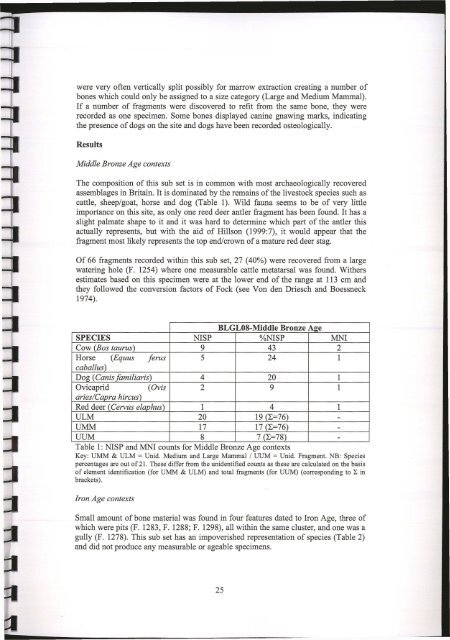Further Excavations At Langtoft. Lincolnshire www - Archaeology ...
Further Excavations At Langtoft. Lincolnshire www - Archaeology ...
Further Excavations At Langtoft. Lincolnshire www - Archaeology ...
Create successful ePaper yourself
Turn your PDF publications into a flip-book with our unique Google optimized e-Paper software.
were very often vertically split possibly for marrow extraction creating a number of<br />
bones which could only be assigned to a size category (Large and Medium Mammal).<br />
If a number of fragments were discovered to refit from the same bone, they were<br />
recorded as one specimen. Some bones displayed canine gnawing marks, indicating<br />
the presence of dogs on the site and dogs have been recorded osteologically.<br />
Results<br />
Middle Bronze Age contexts<br />
The composition of this sub set is in common with most archaeologically recovered<br />
assemblages in Britain. It is dominated by the remains of the livestock species such as<br />
cattle, sheep/goat, horse and dog (Table 1). Wild fauna seems to be of very little<br />
importance on this site, as only one reed deer antler fragment has been found. It has a<br />
slight palmate shape to it and it was hard to determine which part of the antler this<br />
actually represents, but with the aid of Hillson (1999:7), it would appear that the<br />
fragment most likely represents the top end/crown of a mature red deer stag.<br />
Of 66 fragments recorded within this sub set, 27 (40%) were recovered from a large<br />
watering hole (F. 1254) where one measurable cattle metatarsal was found. Withers<br />
estimates based on this specimen were at the lower end of the range at 113 cm and<br />
they followed the conversion factors of Fock (see Von den Driesch and Boessneck<br />
1974).<br />
BLGL08-Middle Bronze Age<br />
SPECIES NISP %NISP MNI<br />
Cow (Bos taurus) 9 43 2<br />
Horse (Equus ferus 5 24 1<br />
caballus)<br />
Dog (Canis familiaris) 4 20 1<br />
Ovicaprid (Ovis 2 9 1<br />
aries/Capra hircus)<br />
Red deer (Cervus elaphus) 1 4 1<br />
ULM 20 19 (1=76) -<br />
UMM 17 17 (L=76) -<br />
UUM 8 7 (1=78) -<br />
Table 1: NISP and MNI counts for Middle Bronze Age contexts<br />
Key: UMM & ULM = Unid. Medium and Large Mammal / UUM = Unid. Fragment. NB: Species<br />
percentages are out of 21. These differ from the unidentified counts as these are calculated on the basis<br />
of element identification (for UMM & ULM) and total fragments (for UUM) (corresponding to S in<br />
brackets).<br />
Iron Age contexts<br />
Small amount of bone material was found in four features dated to Iron Age, three of<br />
which were pits (F. 1283, F. 1288; F. 1298), all within the same cluster, and one was a<br />
gully (F. 1278). This sub set has an impoverished representation of species (Table 2)<br />
and did not produce any measurable or ageable specimens.<br />
25

















